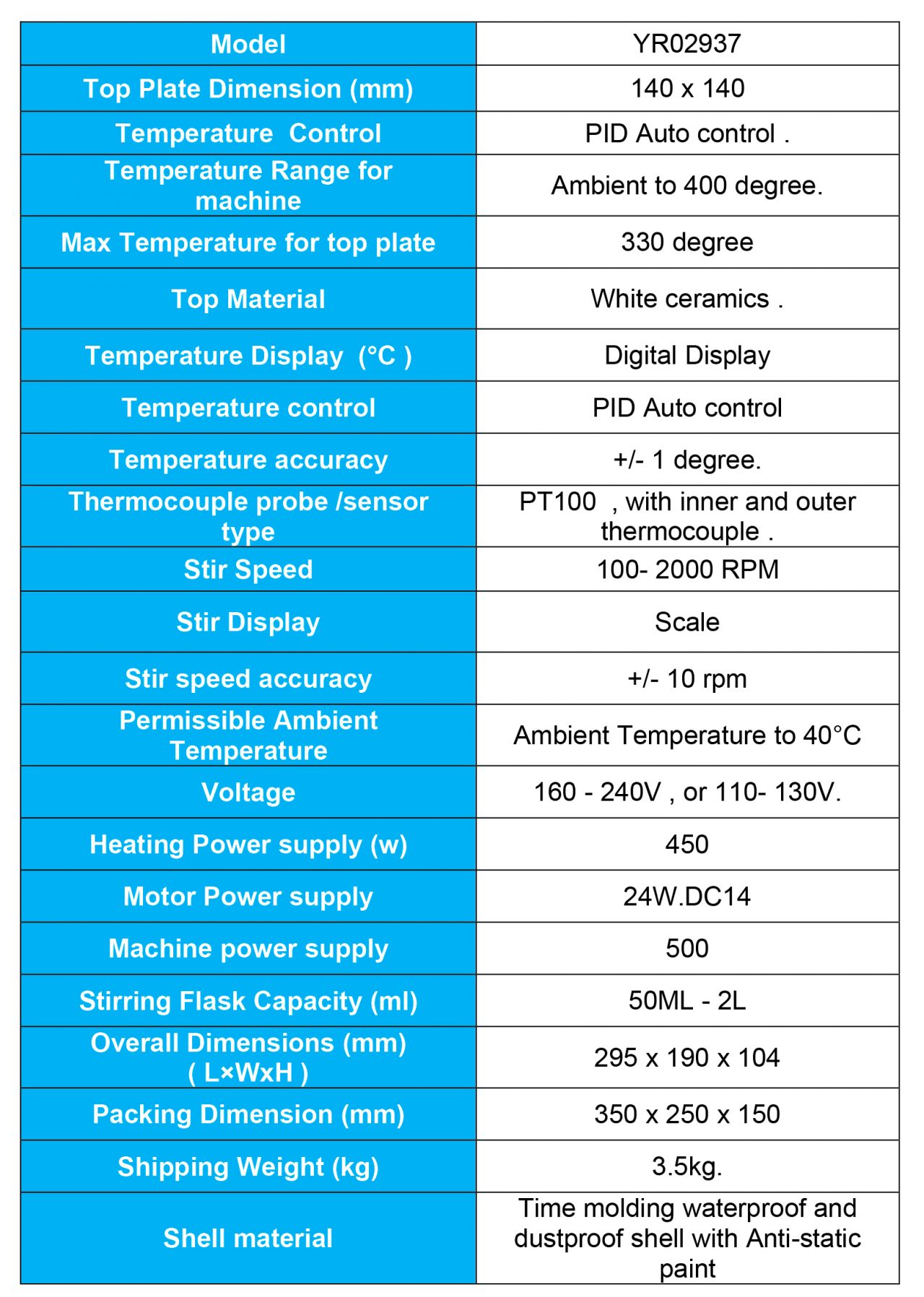The role of magnetic hotplate stirrers is pivotal in laboratory setups that demand precision, reliability, and efficiency. Two standout models in today’s market include the Digital Mini Laboratory Magnetic Hotplate Stirrer YR02937 from Kalstein and the Magnetic Hotplate Stirrer Model SP1840-12 from Scilogex. Understanding the nuances of each can help potential buyers make informed decisions tailored to their specific needs. In this detailed comparison, we will explore the specs, functionalities, and practical applications of each product, emphasizing the advantages the Kalstein model offers.
The Digital Mini Laboratory Magnetic Hotplate Stirrer YR02937 by Kalstein is a sophisticated piece of equipment tailored to meet the needs of diverse laboratory applications. With its compact design, it offers precise temperature control and a user-friendly interface, making it an excellent choice for professionals who value both technology and convenience. On the other hand, the Magnetic Hotplate Stirrer Model SP1840-12 by Scilogex is known for its robust construction and reliability. Although both models serve a similar basic function, the nuances in their design and operation can influence a user’s experience significantly.
| Feature | Kalstein YR02937 | Scilogex SP1840-12 |
|---|---|---|
| Temperature Range | Ambient to 300°C | Ambient to 280°C |
| Stirring Capacity | 1L | 5L |
| Plate Material | Ceramic-Coated | Aluminum |
| Display | Digital | Analog |
| Dimensions | 135 x 150 x 55 mm | 300 x 160 x 90 mm |
| Weight | 1.5 kg | 4 kg |
How They Work
The Digital Mini Laboratory Magnetic Hotplate Stirrer YR02937 operates by utilizing magnetic fields to create a stirring motion within the solution. The ceramic-coated plate ensures even heat distribution, enhancing the precision of temperature adjustments. Its digital interface enables precise control of stirring speed and temperature, catering to complex laboratory needs with ease. Conversely, the Scilogex SP1840-12 model uses similar magnetic principles but offers control via analog settings. Although it provides a larger stirring capacity, its aluminum plate might not offer the same resistance and uniform heat distribution as the ceramic coating of Kalstein’s model.
Uses for the Kalstein Model
The Kalstein YR02937 is used in various applications, including chemical synthesis, microbiology, and sample preparation. Its precise temperature control makes it ideal for scenarios where maintaining specific heat levels is crucial. This model also suits educational settings, allowing students to perform experiments that require reliable and reproducible results.
Types
Magnetic hotplate stirrers generally come in various forms, from basic analog versions to advanced digital models like the Kalstein YR02937. The choice of plate material, such as ceramic versus aluminum, can also affect performance, influencing factors like heat distribution and chemical resistance.
Price in the Market
The price of magnetic hotplate stirrers varies greatly based on the brand, features, and specifications. Generally, models with digital displays and ceramic-coated plates like the Kalstein YR02937 tend to be priced higher due to their advanced features. Prices can range from $200 to $800, depending on the complexity and functionality.
Frequently Asked Questions
What is the maximum temperature for each model?
The Kalstein YR02937 reaches up to 300°C, while the Scilogex SP1840-12 can reach a maximum of 280°C.
Can both stirrers handle the same volume?
No, the Kalstein model is designed for up to 1L, whereas the Scilogex can accommodate up to 5L.
What are the advantages of a ceramic-coated plate?
Ceramic-coated plates provide better heat distribution and chemical resistance compared to aluminum plates, ensuring precise and uniform heating.
Advantages and Disadvantages
Kalstein YR02937 Advantages: The digital interface offers enhanced precision and ease of use. Its compact size allows for easy placement in smaller workspaces, and the ceramic-coated plate provides excellent heat distribution and chemical resistance. These features make it a superior choice for precision-demanding tasks.
Kalstein YR02937 Disadvantages: Although ideal for small-scale tasks, it may not suit larger volumes exceeding 1L.
Scilogex SP1840-12 Advantages: Its ability to handle larger volumes can be beneficial for specific applications requiring greater capacity.
Scilogex SP1840-12 Disadvantages: The absence of a digital display may hinder precise control, and the aluminum plate could limit uniform heat distribution and chemical resistance.
Use of the Product in the Field
In practical scenarios, the Kalstein YR02937 excels in environments requiring highly controlled heating and stirring conditions. Its intuitive digital interface allows users to adjust settings easily, ensuring optimal results in research and experimental applications. The robust build ensures longevity, allowing labs to utilize this equipment for diverse applications over time.
Recommendations
For improved performance and longevity, regularly clean the ceramic plate with mild cleaning solutions to avoid chemical buildup. Also, monitoring the digital controls to regularly calibrate them can ensure continued accuracy. If you frequently work with varying solution volumes, consider your application needs before choosing between models.
Are you looking to integrate precision and innovation in your laboratory work? Kalstein offers the highest quality equipment designed with excellence in mind. Our user-friendly online shopping experience ensures the best prices and satisfaction. Explore our catalog, bring science to life, and become part of our community. Request a quote today through Kalstein Plus.

